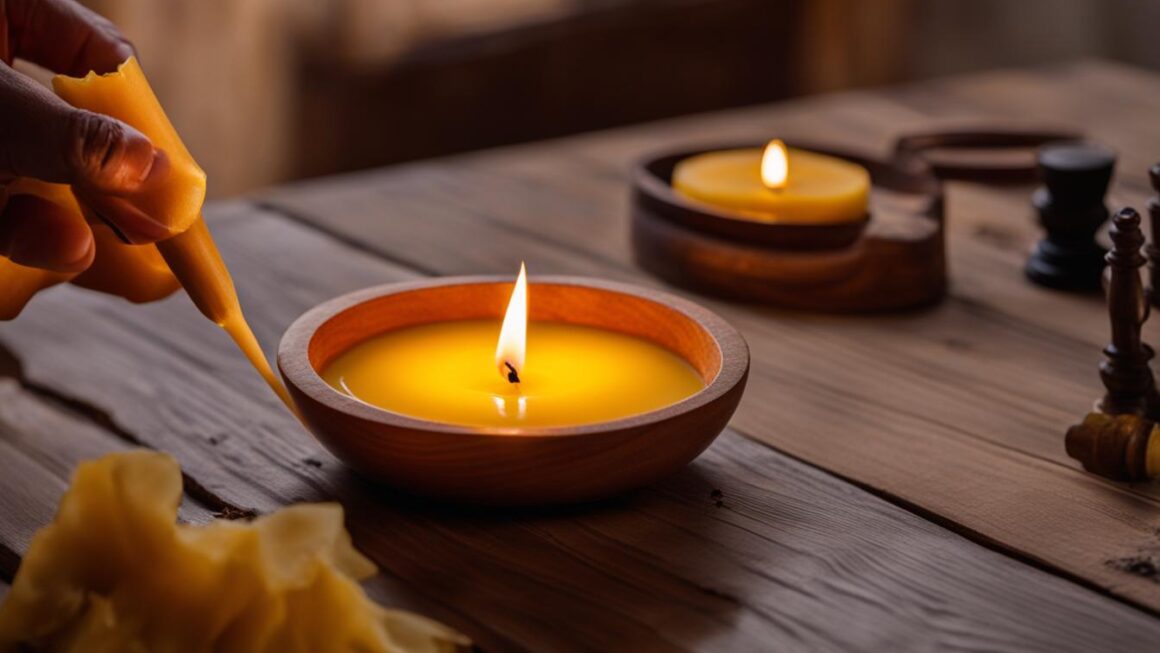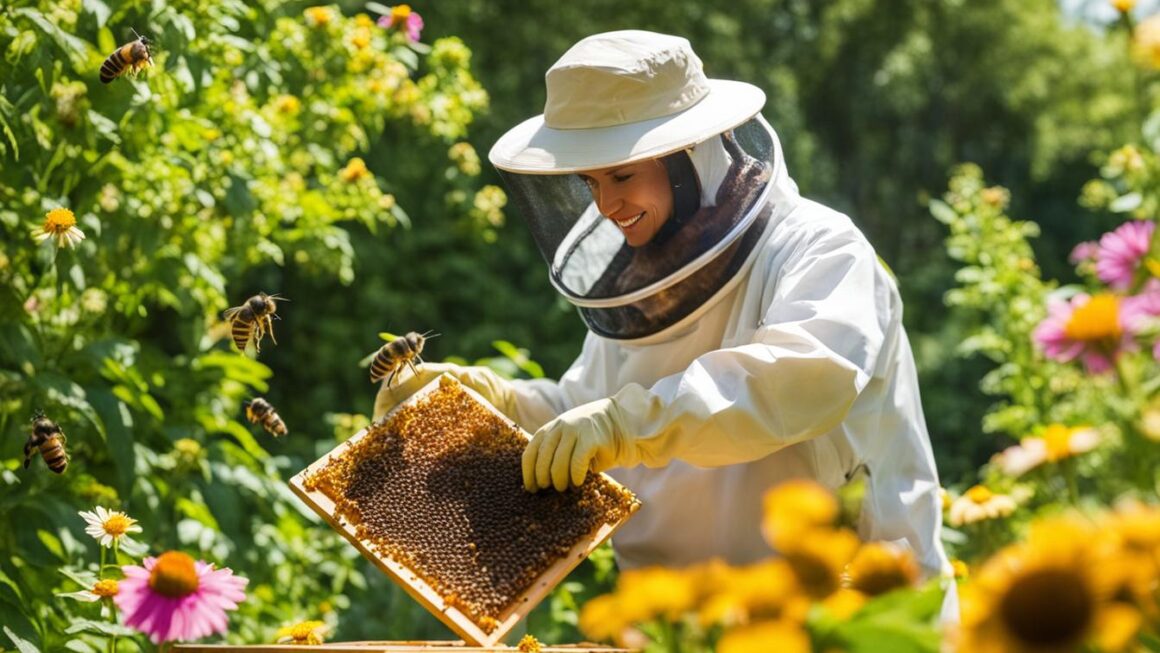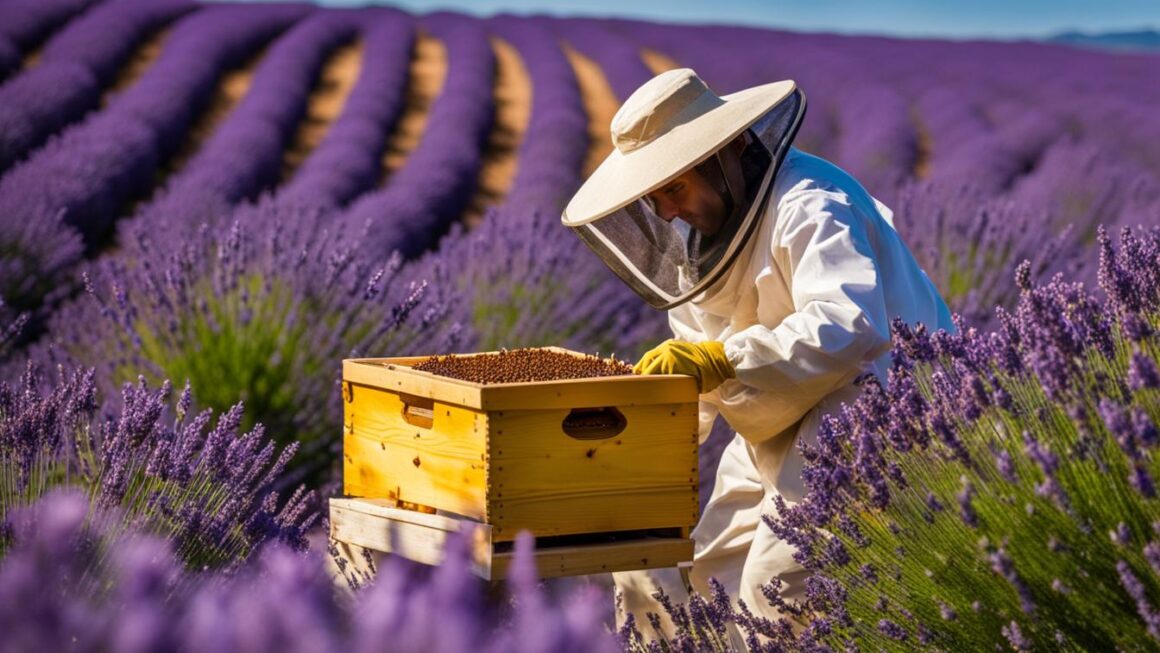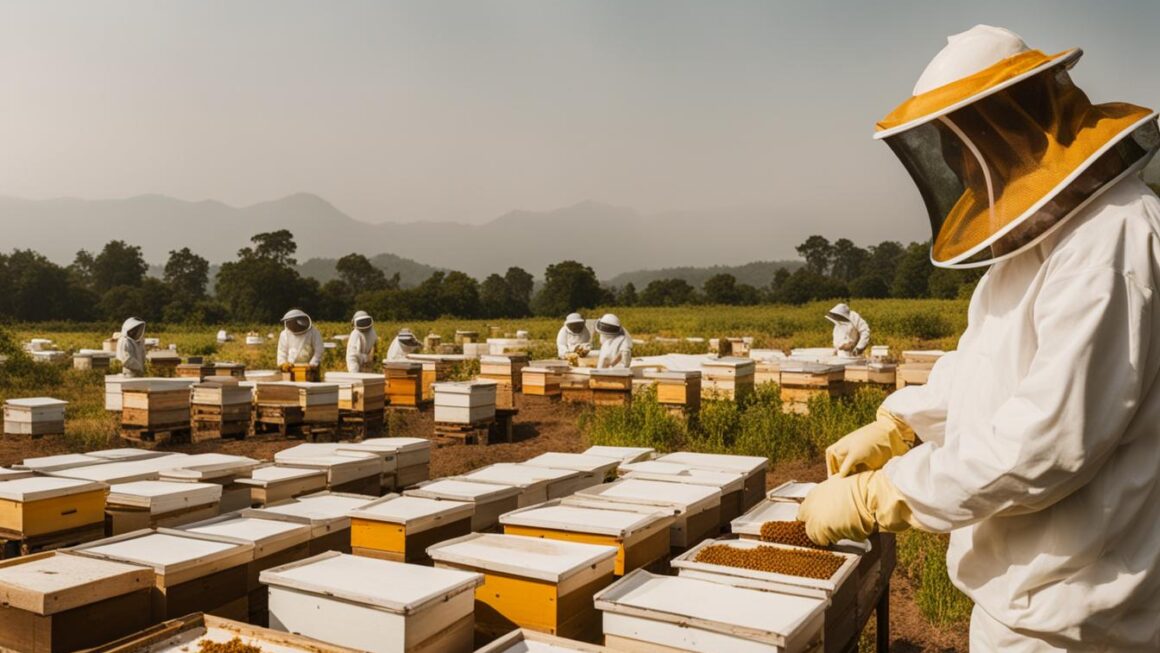Beeswax is a remarkable natural product with countless uses and benefits. From its role in the structure of honeycomb to its incorporation in beauty products and DIY recipes, beeswax is versatile and valuable. It offers benefits such as moisturizing and protecting the skin, serving as a thickening agent in cosmetic formulations, and acting as a natural alternative to plastic wrap. With 101 uses for beeswax, this article explores the many ways you can harness the power of this natural wonder.
Key Takeaways:
- Beeswax is a versatile natural product with countless uses.
- It moisturizes and protects the skin, thickens cosmetic formulations, and can be used as a natural alternative to plastic wrap.
- There are 101 uses for beeswax, making it a valuable resource for DIY projects.
- Beeswax offers numerous benefits for beauty, personal care, home products, food preparation, crafts, and traditional practices.
- When working with beeswax, it is important to follow proper safety precautions and consider individual sensitivities.
The Amazing Properties of Beeswax
Beeswax is an incredible natural substance with numerous beneficial properties. It is anti-inflammatory, antibacterial, and contains vitamin A, which promotes skin health and regeneration. Beeswax forms a protective barrier on the skin while allowing it to breathe, making it an excellent addition to cosmetic products. It also has a high melting point, which helps thicken homemade lotions and creams. In addition, beeswax is water-repellent and has a long shelf life, making it a valuable ingredient in various applications.
One of the remarkable properties of beeswax is its anti-inflammatory nature. This property makes it particularly useful for soothing skin conditions such as eczema, psoriasis, and dermatitis. By forming a barrier on the skin, beeswax helps to lock in moisture and protect against environmental irritants, reducing inflammation and promoting healing.
Furthermore, beeswax has antibacterial properties that can help prevent infection and promote wound healing. It creates a protective layer over the skin, preventing bacteria from entering and causing further damage. This property makes it an ideal ingredient in healing salves, balms, and natural alternatives to products like Neosporin.
“Beeswax forms a protective barrier on the skin while allowing it to breathe, making it an excellent addition to cosmetic products.”
Another fascinating aspect of beeswax is its ability to act as a natural thickening agent. Its high melting point enables it to solidify at room temperature, providing a creamy consistency to lotions and creams. This property is especially beneficial for DIY enthusiasts who prefer making their own natural skincare products. By adding beeswax to homemade formulations, you can achieve the desired texture and enhance the moisturizing properties of your creations.
In summary, beeswax possesses a range of amazing properties that make it a valuable ingredient in various products. Its anti-inflammatory, antibacterial, and thickening properties make it a popular choice for skincare, health remedies, and DIY projects. Whether you’re looking to soothe irritated skin, create homemade cosmetics, or explore artistic endeavors, beeswax offers a natural and versatile solution.
| Property | Description |
|---|---|
| Anti-inflammatory | Reduces inflammation and soothes skin conditions like eczema and dermatitis. |
| Antibacterial | Prevents infection and promotes wound healing. |
| Thickening Agent | Helps thicken lotions and creams for desired texture and moisturizing properties. |
| Water-Repellent | Provides a protective layer and repels moisture, making it ideal for various applications. |
| Long Shelf Life | Extends the lifespan of products and ensures their efficacy over time. |
Beeswax in Beauty and Personal Care Products
Beeswax is a common ingredient in beauty and personal care products, offering a wide range of benefits for the skin and hair. Its natural properties make it a valuable addition to lotions, creams, lip balms, and other cosmetic formulations.
One of the key advantages of using beeswax in beauty products is its ability to create a protective barrier on the skin. This barrier helps retain moisture, preventing dryness and dehydration. Additionally, beeswax acts as a natural humectant, drawing moisture from the air and locking it into the skin. This makes it a particularly beneficial ingredient for individuals with dry or sensitive skin.
The thick and creamy texture of beeswax adds stability to cosmetic formulations, making it an excellent choice for creating creamy lotions and balms. It helps products maintain their consistency and enhances their moisturizing properties. Beeswax also provides a smooth and velvety finish, leaving the skin feeling soft and nourished.
When it comes to lip care, beeswax-based lip balms are a popular choice. The waxy texture of beeswax helps seal in moisture, protecting the delicate skin of the lips from harsh environmental conditions. It also provides a natural shine and a subtle, sweet scent.
| Benefits of Beeswax in Beauty and Personal Care Products |
|---|
| Moisturizes and nourishes the skin |
| Creates a protective barrier |
| Enhances the stability and consistency of formulations |
| Seals in moisture for hydrated lips |
Beeswax for Homemade Natural Remedies
Beeswax is not just a versatile ingredient in beauty products; it also has a wide range of applications in homemade natural remedies. Its anti-inflammatory and antibacterial properties make it an excellent choice for creating healing salves and soothing balms. Beeswax-based remedies provide a chemical-free and sustainable alternative to conventional products.
One popular use of beeswax in homemade remedies is as a natural alternative to Neosporin. By combining beeswax with other healing ingredients like coconut oil and essential oils, you can create a soothing and effective salve for minor cuts, scrapes, and burns. Beeswax forms a protective barrier on the skin, allowing it to heal while preventing further infection.
Additionally, beeswax can be used in homemade chest rubs to alleviate cold and flu symptoms. The natural fragrance of beeswax, combined with essential oils like eucalyptus and peppermint, helps to clear congestion and provide relief from coughing and nasal congestion. By opting for beeswax-based remedies, you can avoid the potential side effects of synthetic ingredients and embrace a more natural approach to self-care.
Table: Comparison of Beeswax-Based Remedies
| Beeswax Remedy | Ingredients | Benefits |
|---|---|---|
| Healing Salve | Beeswax, coconut oil, essential oils | Provides a protective barrier, soothes minor cuts and burns, promotes healing |
| Chest Rub | Beeswax, olive oil, essential oils | Eases congestion, relieves coughing and nasal congestion, promotes sinus and respiratory health |
| Soothing Balm | Beeswax, shea butter, herbal extracts | Moisturizes and nourishes dry, cracked skin, reduces inflammation, soothes irritation |
By harnessing the power of beeswax in homemade natural remedies, you can take control of your well-being and reduce your reliance on commercial products. Whether you’re looking for a natural Neosporin alternative or a soothing chest rub, beeswax provides a safe and effective solution. Explore the possibilities of homemade remedies and discover the healing potential of this natural wonder.
Beeswax for DIY Home Products
Beeswax is widely used in DIY home products due to its versatility and natural properties. It can be incorporated into various homemade creations, providing a natural alternative to store-bought products. Whether you’re looking to make your own deodorant, lotion bars, or lip balms, beeswax can be a key ingredient in these DIY projects.
One popular use of beeswax in DIY home products is furniture polish. By combining beeswax with other natural ingredients, you can create a safe and effective polish for wood furniture. Beeswax not only enhances the shine of the furniture but also helps protect it from moisture and wear.
Another creative use of beeswax is in the production of reusable food wraps. These wraps are a sustainable alternative to plastic cling film and can be used to cover fruits, vegetables, snacks, and bread. Beeswax’s water-repellent properties make it an ideal choice for this purpose, as it helps preserve the freshness of the food while reducing waste.
Table: DIY Home Products with Beeswax
| Product | Description |
|---|---|
| Deodorant | A natural alternative to store-bought deodorants, beeswax can help neutralize odor and keep you feeling fresh. |
| Lotion Bars | These solid bars melt with body heat and provide intense moisture to the skin. Beeswax acts as a natural binder and creates a protective barrier on the skin. |
| Lip Balms | Beeswax-based lip balms offer hydration and protection for dry and chapped lips, making them perfect for year-round use. |
| Furniture Polish | Made with beeswax, natural oils, and vinegar, this furniture polish enhances the shine of wood furniture while protecting it from damage. |
| Reusable Food Wraps | Create eco-friendly food wraps by infusing cloth with beeswax. These wraps can be used to cover food and reduce single-use plastic waste. |
With beeswax, the possibilities for DIY home products are endless. By harnessing the natural properties of beeswax, you can create effective and eco-friendly alternatives to store-bought products while enjoying the satisfaction of making something with your own hands.
Beeswax in Food Preparation and Preservation
Beeswax offers practical applications in the kitchen as well. It can be used to make eco-friendly and reusable food wraps as an alternative to plastic cling film. Beeswax wraps are perfect for covering fruits, vegetables, snacks, and breads, reducing waste and promoting a sustainable lifestyle. In addition, beeswax can be used for cheese waxing, providing a natural and effective way to preserve cheese and prevent the growth of mold. Using beeswax in food preparation and preservation allows for a chemical-free and eco-friendly approach.
| Application | Benefits |
|---|---|
| Eco-friendly food wraps | Reduces waste and promotes sustainability |
| Cheese waxing | Natural preservation method, prevents mold growth |
Beeswax food wraps are an excellent alternative to single-use plastic wrap. They can be easily molded around food items, creating a secure and breathable seal. The natural properties of beeswax, such as its water-repellent and antimicrobial qualities, help keep food fresh for longer. By using beeswax wraps, you not only reduce your plastic waste but also ensure that your food stays protected and flavorful.
“Beeswax wraps are a game-changer in my kitchen. They are so versatile and eco-friendly. I love how they keep my food fresh and help me minimize my use of single-use plastics. Plus, they’re so easy to clean and reuse!”
Benefits of Beeswax Food Wraps:
- Eco-friendly and sustainable
- Reusable and washable
- Provides a breathable seal
- Natural antimicrobial properties
- Keeps food fresh for longer
Cheese waxing is another practical use for beeswax in the kitchen. By applying a layer of melted beeswax to the surface of cheese, you create a protective barrier that helps retain moisture and prevent the growth of mold. This traditional method of cheese preservation has been used for centuries and is still widely practiced today. Whether you’re an amateur cheesemaker or simply want to extend the life of your favorite cheese, beeswax waxing is a natural and effective solution.
With beeswax’s natural properties and versatility, it’s no wonder it has found its way into various aspects of our lives, including food preparation and preservation. From eco-friendly food wraps to cheese waxing, beeswax offers a sustainable and effective solution for minimizing waste and extending the shelf life of our favorite foods.
Beeswax for Crafts and Artistic Creations
Beeswax is a highly versatile material that is widely used in various crafts and artistic creations. Its pliability and ability to hold shape make it an excellent medium for artists and crafters seeking to add texture and dimension to their projects.
One popular art form that utilizes beeswax is batik. Batik is a traditional technique where fabric is dyed, and beeswax is applied to create patterns and resist color. The wax acts as a barrier, preventing the dye from reaching certain areas and allowing for intricate designs to be created.

Beeswax Batik Process:
- Warm the beeswax in a double boiler until it becomes liquid.
- Using a brush or a tjanting tool, apply the melted beeswax to the fabric in the desired pattern.
- Allow the wax to cool and harden.
- Submerge the fabric in dye, making sure the waxed areas remain untouched by the dye.
- Remove the fabric from the dye and let it dry.
- To remove the wax, place the fabric between absorbent paper and iron it, allowing the wax to melt and be absorbed by the paper.
In addition to batik, beeswax can be used to seal and protect artwork. It acts as a natural varnish, preserving the colors and enhancing the overall appearance of paintings and mixed media artwork. The beeswax can be melted and applied with a brush or a cloth, creating a protective layer that adds depth and richness to the artwork.
Beeswax is a valuable tool for artists and crafters, providing a unique texture and enhancing the visual impact of their creations.
Benefits of Beeswax in Crafts:
- Provides a malleable and pliable material for artistic expression
- Creates texture and dimension in artwork and crafts
- Acts as a natural varnish, preserving and enhancing the colors of paintings
- Eco-friendly and sustainable alternative to synthetic art materials
Whether you’re creating batik designs or sealing your artwork, beeswax offers a range of possibilities for artists and crafters alike. With its natural properties and versatility, beeswax is a valuable addition to any creative endeavor.
Beeswax for Household Maintenance
Beeswax isn’t just useful for beauty products and DIY crafts; it also has practical applications for household maintenance. Its natural properties make it an excellent choice for various tasks around the home.
One of the key uses of beeswax in household maintenance is as a lubricant. It can be applied to drawers, hinges, and other moving parts to prevent rusting and ensure smooth operation. The water-repellent properties of beeswax also make it effective for coating nails and screws, protecting the wood from splitting.
Additionally, beeswax can be used to polish and protect wooden furniture. By applying a thin layer of beeswax and gently buffing it, you can restore shine and enhance the natural beauty of your wood pieces. Beeswax is also ideal for conditioning cutting boards and wooden utensils, extending their lifespan and keeping them in top condition.
Table: Beeswax Household Uses
| Household Use | Description |
|---|---|
| Lubricant | Prevents rusting and ensures smooth operation of moving parts |
| Wood Polish | Restores shine and protects wooden furniture |
| Protective Coating | Water-repellent properties protect wood from splitting |
| Conditioning Agent | Conditions cutting boards and wooden utensils |
With beeswax, you can take a natural and sustainable approach to maintaining various items in your home. By harnessing the power of this versatile substance, you can keep your household items in excellent condition while reducing your environmental impact.
Beeswax in Traditional Crafts and Practices
Beeswax has a rich history in traditional crafts and practices, where its unique properties and versatility have been utilized for centuries. One such example is its use in Ukrainian egg decorating, also known as pysanky. In this intricate art form, beeswax is melted and applied to the eggshell with a stylus, creating intricate designs. The beeswax acts as a resist, preventing dye from reaching the areas covered, resulting in stunning patterns and vibrant colors. This traditional craft showcases the beauty and creativity that can be achieved with beeswax.
Another traditional use of beeswax lies in candle-making. Beeswax candles have been valued for their clean burning and natural fragrance. The beeswax is melted and poured into molds, creating beautiful and long-lasting candles that emit a soft, warm glow. The natural honey scent of beeswax adds a soothing and pleasant aroma to any space. Whether used for religious rituals, special occasions, or simply to create an inviting ambiance, beeswax candles have stood the test of time as a traditional favorite.
Beeswax’s malleability and ability to hold shape make it ideal for traditional crafts and practices. Its natural adhesive properties allow it to be seamlessly incorporated into different artistic expressions. Whether it’s creating intricate designs on eggs or molding it into candles, beeswax has played a significant role in preserving ancient traditions and honoring cultural heritage.
Table: Uses of Beeswax in Traditional Crafts and Practices
| Traditional Craft | Description |
|---|---|
| Ukrainian Egg Decorating | Beeswax is melted and applied to the eggshell to create intricate designs and patterns. |
| Candle-Making | Beeswax is melted and molded into candles, known for their clean burning and natural fragrance. |
| Artistic Expressions | Beeswax’s malleability allows it to be shaped and molded for various artistic creations. |
Through these traditional crafts and practices, beeswax continues to be embraced and celebrated for its beauty, versatility, and connection to nature. It serves as a reminder of the rich cultural heritage and the enduring legacy of this natural wonder.
Where to Buy Beeswax and Tips for Working with It
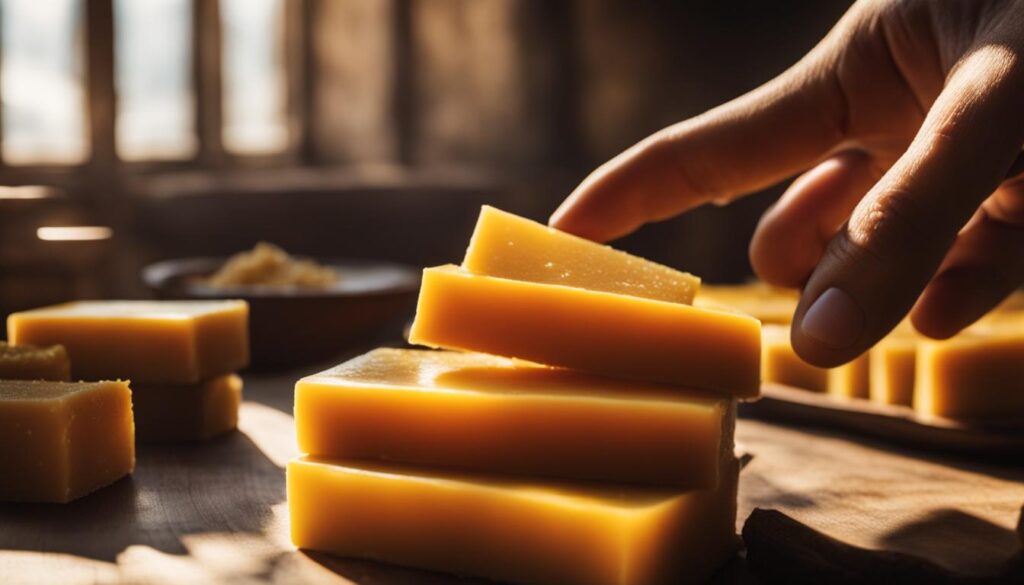
Beeswax is a valuable natural substance with numerous uses and benefits. Whether you’re a DIY enthusiast or simply looking to incorporate more natural products into your life, knowing where to buy high-quality beeswax is essential.
If you prefer supporting local businesses and beekeepers, you can find beeswax at farmers’ markets or directly from beekeepers in your area. Local beekeepers often sell beeswax alongside honey and other bee-related products. By buying from them, you not only get access to fresh, locally sourced beeswax but also support sustainable beekeeping practices.
Furthermore, you can also find beeswax online. Many online retailers specialize in natural ingredients and offer various forms of beeswax, such as pellets, bars, or blocks. When purchasing online, make sure to read customer reviews and check the product’s quality and origin to ensure you’re getting the best beeswax for your needs.
Tips for Working with Beeswax
- Use a double boiler: Beeswax has a low melting point, so it’s important to melt it gently using a double boiler. This method prevents overheating and ensures a smooth consistency.
- Temperature control: To avoid the risk of burning or scorching the beeswax, use a thermometer to monitor the temperature. The ideal melting point is between 145°F and 150°F (63°C-66°C).
- Be cautious with open flames: Beeswax is flammable, so never melt it directly over an open flame. Always use a heat source that provides gentle and indirect heat, such as a water bath or an electric wax melter.
- Additives and scents: If desired, you can enhance the properties and fragrance of beeswax by adding natural additives and essential oils. However, ensure that the additives are suitable for use with beeswax and do not compromise its quality.
- Storage: Store beeswax in a cool, dry place away from direct sunlight to maintain its integrity. Beeswax has a long shelf life and can be used for several years if stored properly.
By following these tips and guidelines, you can make the most of your beeswax and enjoy the benefits it offers in various DIY projects, beauty products, and household applications.
Beeswax Safety and Precautions
While beeswax is generally safe to use, it is important to take certain precautions when working with it. Beeswax has a low boiling point and a flash point, so it is essential to monitor the temperature carefully to prevent accidents or burning. When using beeswax in recipes or DIY products, it is important to consider any allergies or sensitivities to bee products. It is always recommended to perform a patch test before using beeswax-based products on the skin. Following safety guidelines and considering individual sensitivities will ensure a safe and enjoyable experience with beeswax.
When melting beeswax, it is crucial to use a double boiler or a dedicated melting pot to prevent direct exposure to heat sources. This will minimize the risk of overheating or scorching the beeswax, which can result in a fire hazard. Additionally, never leave melting beeswax unattended, as it can quickly reach its flash point and ignite if exposed to an open flame or excessive heat.
If you have a known allergy to bee stings, it is important to exercise caution when using beeswax products. Although rare, some individuals may experience an allergic reaction to beeswax, which can manifest as skin irritation, itching, or even difficulty breathing in severe cases. If you notice any adverse reactions after using beeswax, discontinue use immediately and seek medical attention if necessary.
Proper storage of beeswax is also crucial to maintain its quality and prevent contamination. Store beeswax in a cool, dry place away from direct sunlight, moisture, and strong odors. This will help preserve its natural properties and extend its shelf life. It is also recommended to store beeswax in airtight containers or bags to minimize exposure to air, which can cause the wax to become brittle or lose its effectiveness over time.
Safe Handling and Cleanup Tips:
- Wear protective gloves and long sleeves when handling hot beeswax to prevent burns or skin irritation.
- Use a dedicated workspace or cover the area with wax paper or newspaper to make cleanup easier.
- If any beeswax spills or drips onto surfaces, wait for it to cool and harden before attempting to clean it. Gently scrape off the hardened wax with a plastic spatula or credit card.
- For smaller wax spills or stains on fabric, place a paper towel or cloth over the affected area and use a warm iron to melt and absorb the wax. Repeat this process with clean paper towels until the wax is completely removed.
By following these safety precautions and guidelines, you can enjoy the benefits and versatility of beeswax while minimizing potential risks. Whether you’re using beeswax for personal care, DIY projects, or artistic endeavors, proper handling and awareness ensure a safe and rewarding experience.
Conclusion
Beeswax is truly a remarkable natural substance that offers a multitude of uses and benefits. Whether it’s in the beauty industry, personal care products, DIY home projects, or traditional crafts, beeswax has proven to be a versatile and valuable ingredient. Its anti-inflammatory and antibacterial properties make it a popular choice for skincare, while its water-repellent and adhesive qualities make it ideal for various household applications.
This natural wonder not only enhances the effectiveness of products but also promotes a sustainable and eco-friendly lifestyle. By incorporating beeswax into your daily routines, you can reduce your reliance on synthetic ingredients and contribute to a greener future. Furthermore, purchasing beeswax from local beekeepers supports their vital work and strengthens community ties.
In conclusion, beeswax opens up a world of possibilities for health, beauty, home, and beyond. Whether you’re looking to moisturize and protect your skin, create homemade remedies, or explore your artistic side, beeswax is a versatile solution that can unlock your creativity and empower you to live a more natural and environmentally conscious life.
FAQ
Is beeswax safe to use on the skin?
Yes, beeswax is generally safe to use on the skin. However, it is always recommended to perform a patch test before using beeswax-based products to check for any allergies or sensitivities to bee products.
Where can I buy beeswax?
Beeswax can be purchased from various sources, including local beekeepers and online retailers. Buying locally supports beekeepers and allows for a more sustainable and community-oriented approach.
How can I work with beeswax?
When working with beeswax, it is important to have the necessary tools and equipment, such as a double boiler and a thermometer. Beeswax is melted at a specific temperature range to ensure its proper use and consistency. Buying quality beeswax and following proper techniques for working with it will ensure the best results in your DIY projects.
What are the benefits of beeswax in beauty products?
Beeswax creates a protective barrier on the skin while allowing it to breathe, making it an excellent addition to cosmetic products. It moisturizes and protects the skin, adds thickness to lotions and creams, and enhances the moisturizing properties of lip balms.
How can beeswax be used in food preparation?
Beeswax can be used to make reusable food wraps as an alternative to plastic cling film. Beeswax wraps are perfect for covering fruits, vegetables, snacks, and breads, reducing waste and promoting a sustainable lifestyle. Beeswax can also be used for cheese waxing, providing a natural and effective way to preserve cheese and prevent the growth of mold.
Can beeswax be used for crafts and artistic creations?
Yes, beeswax is a popular material for crafts and artistic creations. It can be used to create textured designs in the art of batik, seal and protect artwork, and enhance and preserve the colors of paintings. Its malleability and ability to hold shape make it ideal for these traditional crafts and practices.
Are there any precautions when working with beeswax?
Yes, it is important to take certain precautions when working with beeswax. Beeswax has a low boiling point and a flash point, so it is essential to monitor the temperature carefully to prevent accidents or burning. It is also recommended to consider any allergies or sensitivities to bee products and perform a patch test before using beeswax-based products on the skin.
What are the practical uses of beeswax in the home?
Beeswax can be used as a lubricant for drawers, hinges, and other moving parts to prevent rusting and ensure smooth operation. It can also be used to polish wood furniture, condition cutting boards and wooden utensils, and protect the end grain of cut wood from cracking. Beeswax provides a natural and sustainable solution for maintaining various items in the home.
What are some traditional uses of beeswax?
Beeswax is used in Ukrainian egg decorating to create intricate designs and patterns on eggs. The beeswax acts as a resist, preventing dye from reaching certain areas. Beeswax is also a key ingredient in candle-making, with beeswax candles known for their clean burning and natural fragrance.
What are the properties of beeswax?
Beeswax is anti-inflammatory, antibacterial, and contains vitamin A, which promotes skin health and regeneration. It forms a protective barrier on the skin while allowing it to breathe, making it an excellent addition to cosmetic products. Beeswax also has a high melting point, which helps thicken homemade lotions and creams.
How can beeswax be used in homemade remedies?
Beeswax can be used to make healing salves, soothing balms, and natural alternatives to products like Neosporin. Its anti-inflammatory and antibacterial properties make it an excellent choice for treating minor injuries, soothing cracked skin, and relieving cold and flu symptoms.
What are the practical uses of beeswax in DIY home products?
Beeswax can be incorporated into homemade deodorant, lotion bars, and lip balms, providing natural alternatives to store-bought products. It can also be used to create furniture polish, natural wood preservatives, and reusable food wraps. Beeswax’s water-repellent properties make it ideal for protecting wood, while its pliability and adhesive qualities make it suitable for crafting various household items.

